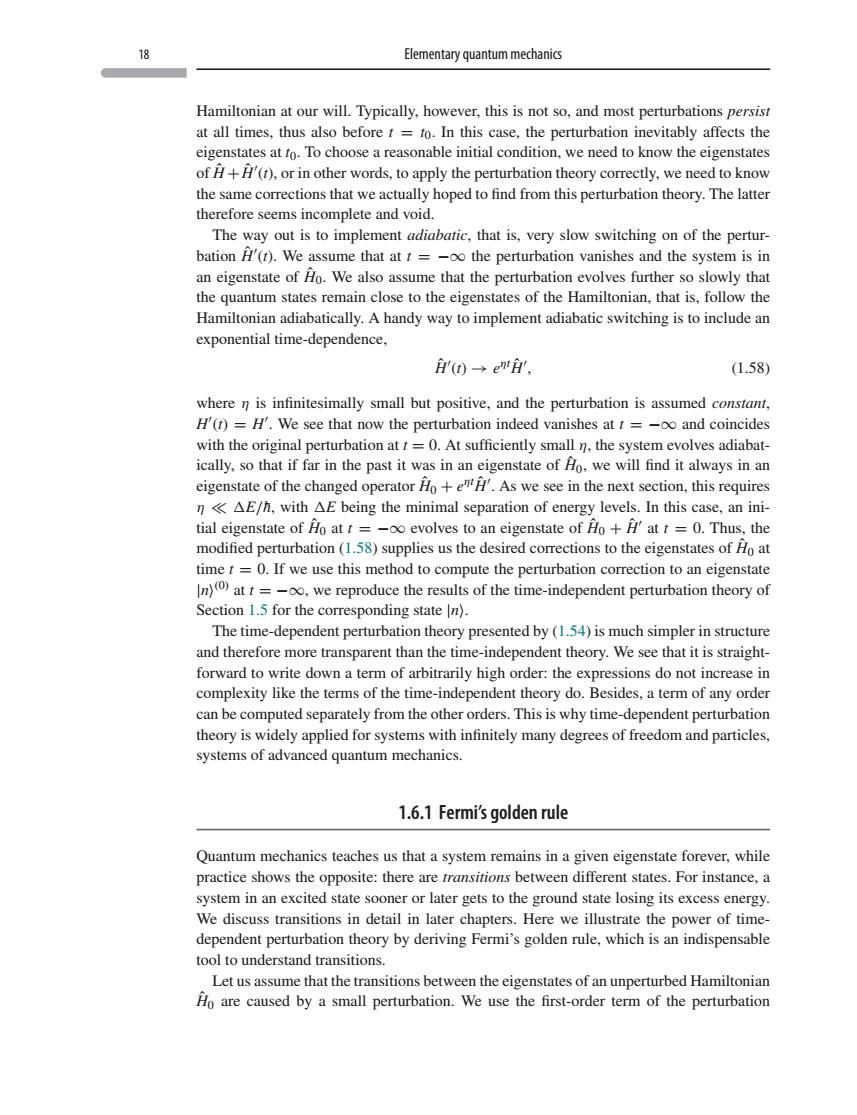正在加载图片...

8 Elementary quantum mechanics Hamiltonian at our will.Typically,however,this is not so,and most perturbations persist at all times.thusaso beforeIn this case.the perturbation inevitably affects the we need to know the igenstate the same corrections that we actually hoped to find from this perturbation theory.The latter therefore seems incomplete and void. The way out is to implement adiabatic.that is.very slow switching on of the pertur bation A'(t).We asst e that at t=-oo the pertu tion vanishes and the system is in an eigenstate of Ho.We also assum that the perturbation evolves further so slowly tha the quantum states remain close to the eigenstates of the Hamiltonian,that is,follow the Hamiltonian adiabatically.A handy way to implement adiabatic switching is to include an exponential time-dependence. 0→e严讯, (1.58) where n is infinitesimally small but positive,and the perturbation is assumed constant, H'(t)=H'.We see that now the perturbation indeed vanishes at t =-oo and coincides with the original perturbation at=0.At sufficiently small n the system evolves adiabat- ically,so that if far in the t was in an state of Ao will find it al cinstats of the chanted operators we see in the npext secto pas on,this require n<AE/h,with AE being the minimal separation of energy levels.In this case,an ini- tial eigenstate of Ho at t =-oo evolves to an eigenstate of Ao+A'at t =0.Thus,the modified perturbation(1.58)supplies us the desired corrections to the eigenstates of o at time.If we use this method to comute the perturbation toa )at we reproduce the results of the time-independent perturbation theory of Section 1.5 for the corresponding state n). The time-dependent perturbation theory presented by(1.54)is much simpler in structure and therefore more transparent than the time-independent theory.We see that it is straight- forward to write down a term of arbitrarily high order:the expressions do not increase in complexity like thet of the tim indepe ory do.Besides,at erm of an can be computed separately from the other orders.This is why time-dependent perturbatio theory is widely applied for systems with infinitely many degrees of freedom and particles, systems of advanced quantum mechanics. 1.6.1 Fermi's golden rule Quantum mechanics teaches us that a system remains in a given eigenstate forever,while practice shows the opposite:there are transitions between different states.For instance.a system in an excited state sooner or later gets to the ground state losing its excess energy We discuss transitions in detail in later chapters.Here we illustrate the power of time ry by deriving Fermi's golden rule,which is an indispensable Let us assume that the transitions between the eigenstates of an unperturbed Hamiltonian Ao are caused by a small perturbation.We use the first-order term of the perturbation18 Elementary quantum mechanics Hamiltonian at our will. Typically, however, this is not so, and most perturbations persist at all times, thus also before t = t0. In this case, the perturbation inevitably affects the eigenstates at t0. To choose a reasonable initial condition, we need to know the eigenstates of Hˆ +Hˆ (t), or in other words, to apply the perturbation theory correctly, we need to know the same corrections that we actually hoped to find from this perturbation theory. The latter therefore seems incomplete and void. The way out is to implement adiabatic, that is, very slow switching on of the perturbation Hˆ (t). We assume that at t = −∞ the perturbation vanishes and the system is in an eigenstate of Hˆ 0. We also assume that the perturbation evolves further so slowly that the quantum states remain close to the eigenstates of the Hamiltonian, that is, follow the Hamiltonian adiabatically. A handy way to implement adiabatic switching is to include an exponential time-dependence, Hˆ (t) → eηt Hˆ , (1.58) where η is infinitesimally small but positive, and the perturbation is assumed constant, H (t) = H . We see that now the perturbation indeed vanishes at t = −∞ and coincides with the original perturbation at t = 0. At sufficiently small η, the system evolves adiabatically, so that if far in the past it was in an eigenstate of Hˆ 0, we will find it always in an eigenstate of the changed operator Hˆ 0 + eηt Hˆ . As we see in the next section, this requires η
E/h¯, with
E being the minimal separation of energy levels. In this case, an initial eigenstate of Hˆ 0 at t = −∞ evolves to an eigenstate of Hˆ 0 + Hˆ at t = 0. Thus, the modified perturbation (1.58) supplies us the desired corrections to the eigenstates of Hˆ 0 at time t = 0. If we use this method to compute the perturbation correction to an eigenstate |n(0) at t = −∞, we reproduce the results of the time-independent perturbation theory of Section 1.5 for the corresponding state |n. The time-dependent perturbation theory presented by (1.54) is much simpler in structure and therefore more transparent than the time-independent theory. We see that it is straightforward to write down a term of arbitrarily high order: the expressions do not increase in complexity like the terms of the time-independent theory do. Besides, a term of any order can be computed separately from the other orders. This is why time-dependent perturbation theory is widely applied for systems with infinitely many degrees of freedom and particles, systems of advanced quantum mechanics. 1.6.1 Fermi’s golden rule Quantum mechanics teaches us that a system remains in a given eigenstate forever, while practice shows the opposite: there are transitions between different states. For instance, a system in an excited state sooner or later gets to the ground state losing its excess energy. We discuss transitions in detail in later chapters. Here we illustrate the power of timedependent perturbation theory by deriving Fermi’s golden rule, which is an indispensable tool to understand transitions. Let us assume that the transitions between the eigenstates of an unperturbed Hamiltonian Hˆ 0 are caused by a small perturbation. We use the first-order term of the perturbation